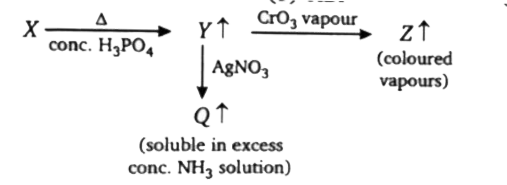Which of the following atoms could form an anion with -2 charge?
Se
Po
Cl
H
The correct Answer is:A
To determine which of the given atoms can form an anion with a -2 charge, we will analyze each atom based on its position in the periodic table and its ability to gain electrons.
1. Identify the Atoms: The atoms in question are Selenium (Se), Polonium (Po), Chlorine (Cl), and Hydrogen (H).
2. Determine the Group of Each Atom:
- Selenium (Se): This element is in Group 16 (the oxygen family).
- Polonium (Po): This element is also in Group 16 (the oxygen family).
- Chlorine (Cl): This element is in Group 17 (the halogens).
- Hydrogen (H): This element is in Group 1.
3. Understand the Electron Configuration:
- Selenium (Se): The electron configuration is (Ar) 4s² 3d¹⁰ 4p⁴. It needs to gain 2 electrons to achieve a stable octet, forming Se²⁻.
- Polonium (Po): The electron configuration is (Xe) 6s² 4f¹⁴ 5d¹⁰ 6p⁴. Like selenium, it can gain 2 electrons to form Po²⁻.
- Chlorine (Cl): The electron configuration is (Ne) 3s² 3p⁵. Chlorine typically forms a -1 charge (Cl⁻) by gaining 1 electron.
- Hydrogen (H): The electron configuration is 1s¹. Hydrogen can either lose an electron to form H⁺ or gain one to form H⁻, but it does not form a -2 charge.
4. Conclusion:
- The elements that can form anions with a -2 charge are Selenium (Se) and Polonium (Po). Chlorine can only form a -1 charge, and Hydrogen does not form a -2 charge.
Final Answer:
The atoms that could form an anion with a -2 charge are Selenium (Se) and Polonium (Po).
---
- Selenium (Se): This element is in Group 16 (the oxygen family).
- Polonium (Po): This element is also in Group 16 (the oxygen family).
- Chlorine (Cl): This element is in Group 17 (the halogens).
- Hydrogen (H): This element is in Group 1.
- Selenium (Se): The electron configuration is (Ar) 4s² 3d¹⁰ 4p⁴. It needs to gain 2 electrons to achieve a stable octet, forming Se²⁻.
- Polonium (Po): The electron configuration is (Xe) 6s² 4f¹⁴ 5d¹⁰ 6p⁴. Like selenium, it can gain 2 electrons to form Po²⁻.
- Chlorine (Cl): The electron configuration is (Ne) 3s² 3p⁵. Chlorine typically forms a -1 charge (Cl⁻) by gaining 1 electron.
- Hydrogen (H): The electron configuration is 1s¹. Hydrogen can either lose an electron to form H⁺ or gain one to form H⁻, but it does not form a -2 charge.
- The elements that can form anions with a -2 charge are Selenium (Se) and Polonium (Po). Chlorine can only form a -1 charge, and Hydrogen does not form a -2 charge.
The atoms that could form an anion with a -2 charge are Selenium (Se) and Polonium (Po).
Topper's Solved these Questions
- CLASSIFICATION OF ELEMENTS AND PERIODICITY IN PROPERTIES BOOK - VMC MODULES ENGLISHCHAPTER - CLASSIFICATION OF ELEMENTS AND PERIODICITY IN PROPERTIES EXERCISE - LEVEL -2
50 Videos
- CLASSIFICATION OF ELEMENTS AND PERIODICITY IN PROPERTIES BOOK - VMC MODULES ENGLISHCHAPTER - CLASSIFICATION OF ELEMENTS AND PERIODICITY IN PROPERTIES EXERCISE - LEVEL -2 Numerical Value Type for JEE Main
13 Videos
- CLASSIFICATION OF ELEMENTS AND PERIODICITY IN PROPERTIES BOOK - VMC MODULES ENGLISHCHAPTER - CLASSIFICATION OF ELEMENTS AND PERIODICITY IN PROPERTIES EXERCISE - JEE ADVANCE (ARCHIVE)
30 Videos
- CHEMICAL THERMODYNAMICS BOOK - VMC MODULES ENGLISHCHAPTER - CHEMICAL THERMODYNAMICS EXERCISE - IN - CHAPTER EXERCISE - L
10 Videos
- ELECTROCHEMISTRYBOOK - VMC MODULES ENGLISHCHAPTER - ELECTROCHEMISTRYEXERCISE - IMPECCABLE
50 Videos
Similar Questions
Knowledge Check
Which of the following could be an integer?
AThe average of two consecutive integersBThe average of three consective integersCThe average of four consecutive integersDThe average of six consecutive integersWhich of the following statements regarding an anion is not true?
AThe gain of an electron leads to the formation of an anion.BThe radius of the anion is larger than the atomic radius of its parent atom.CThe effective nuclear charge increases when an anion is formedDElectron cloud expands due to increased repulsion among the electrons.

Which of the following anion cannot be in X?
View SolutionElements of which of the following groups will form anions most readily ?
View SolutionWhich of the following is an anionic detergent ?
View SolutionWhich of the following compounds could liberate CO2 with aqueous NaHCO3?
View SolutionWhich of the following oxy anion is metaborate ion ?
View SolutionWhich of the following rules could explain the presence of three unpaired electrons in N-atom?
View Solution
